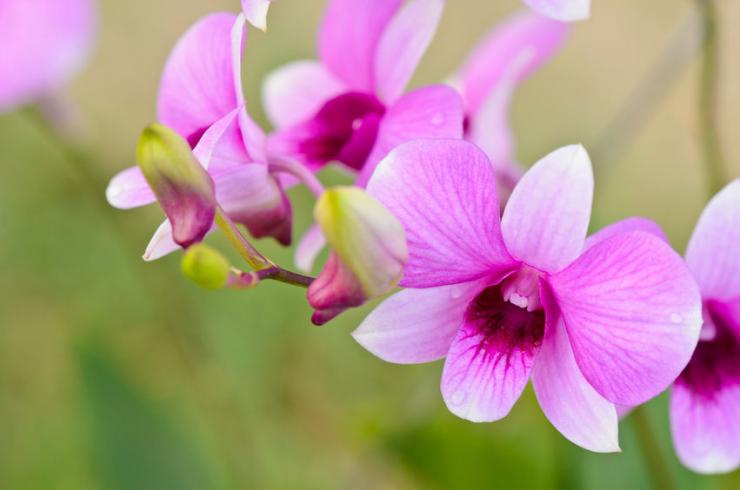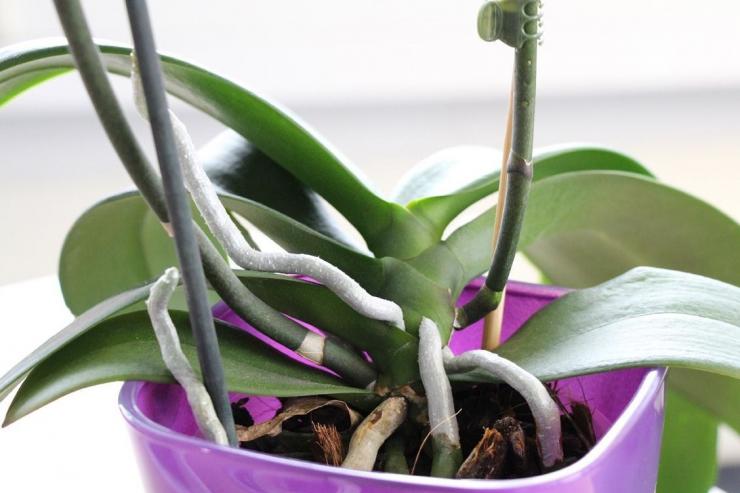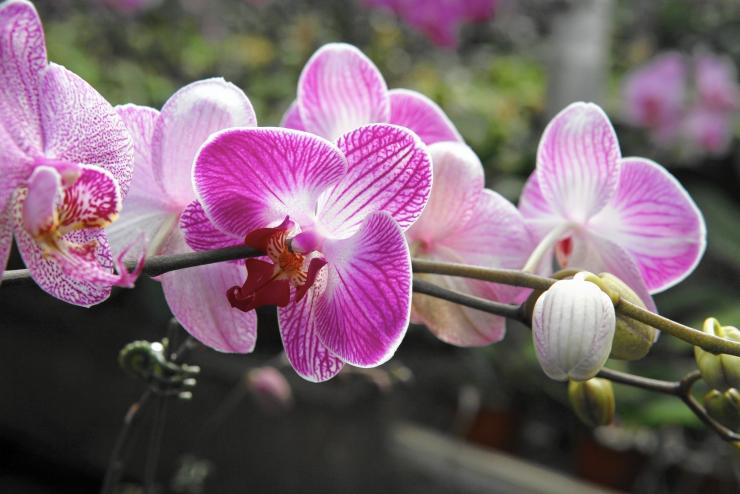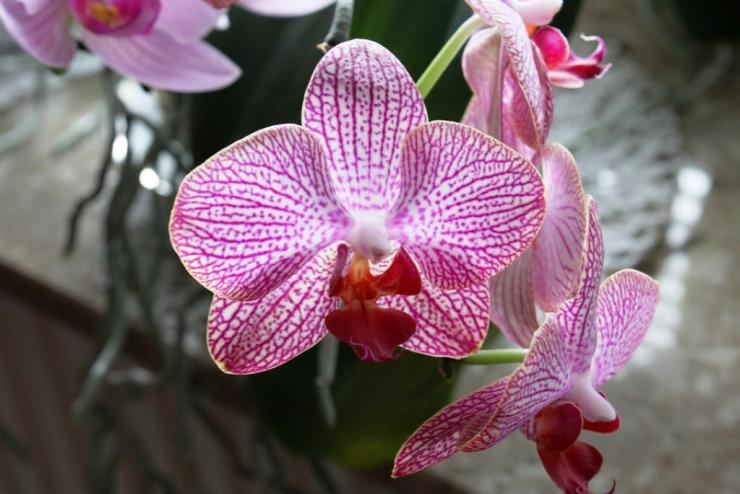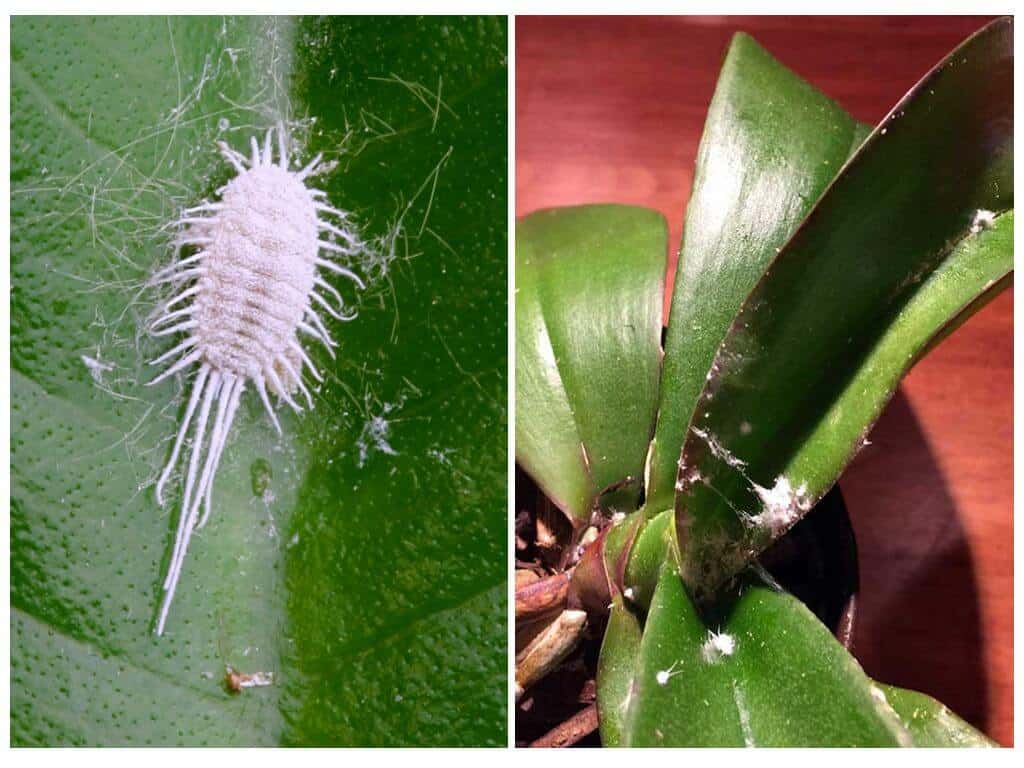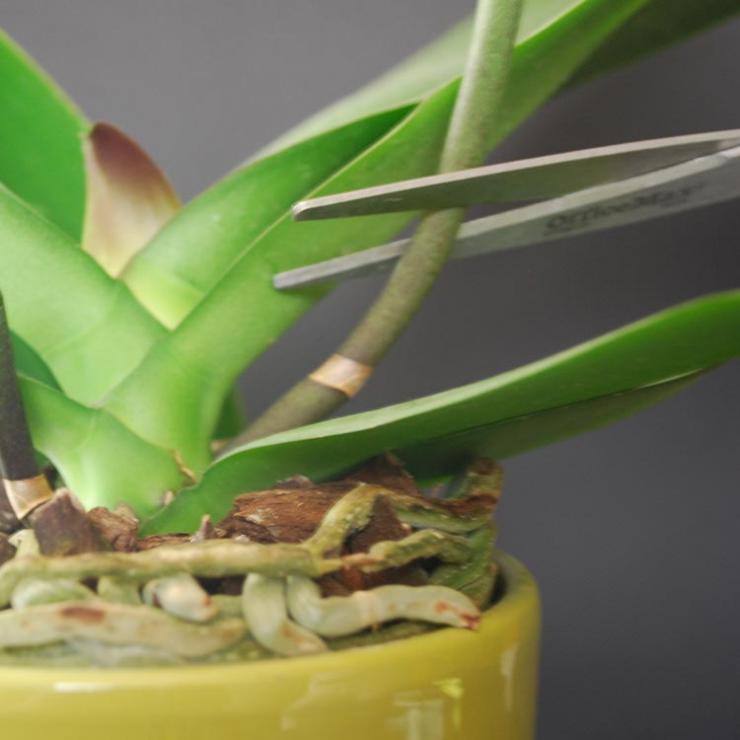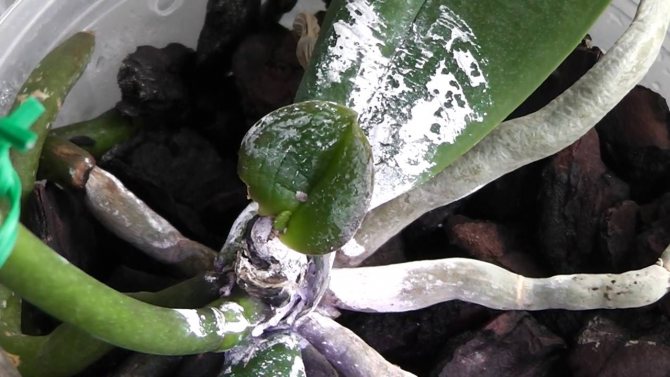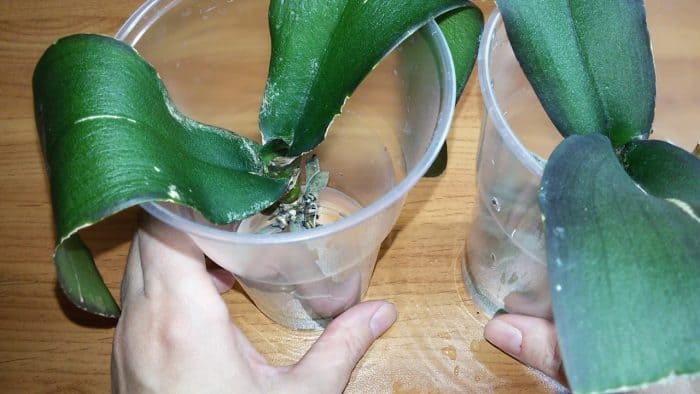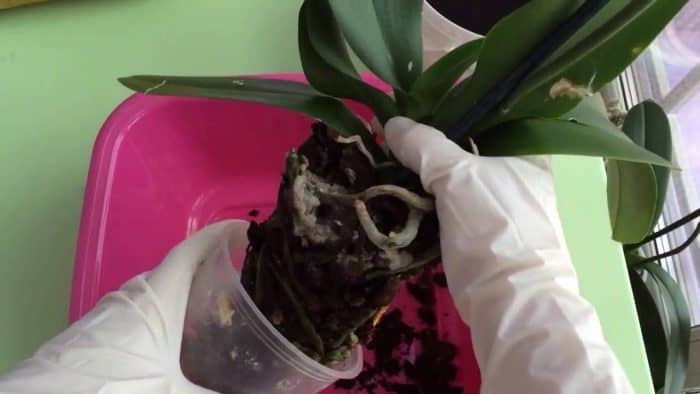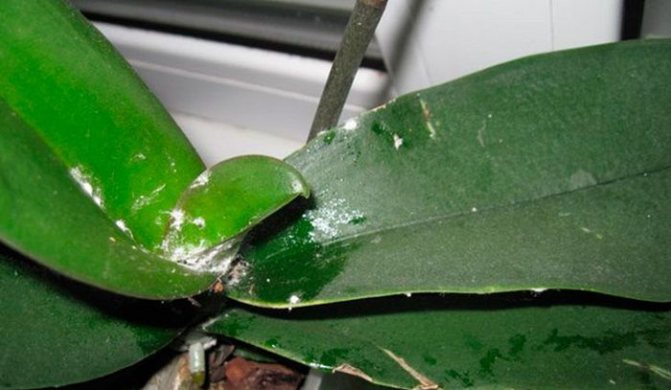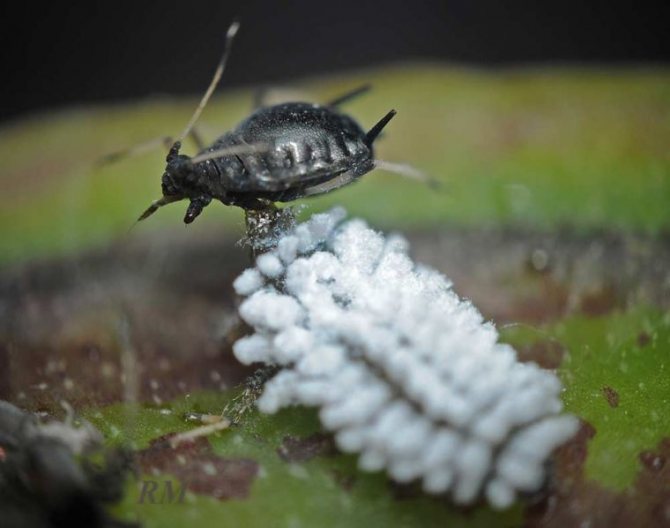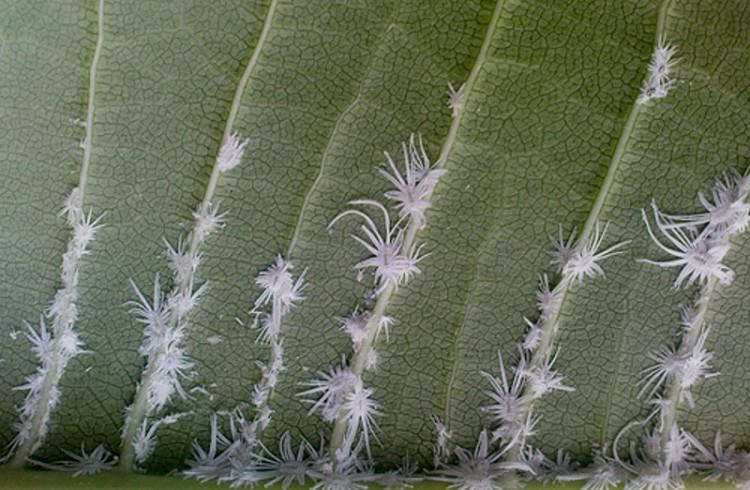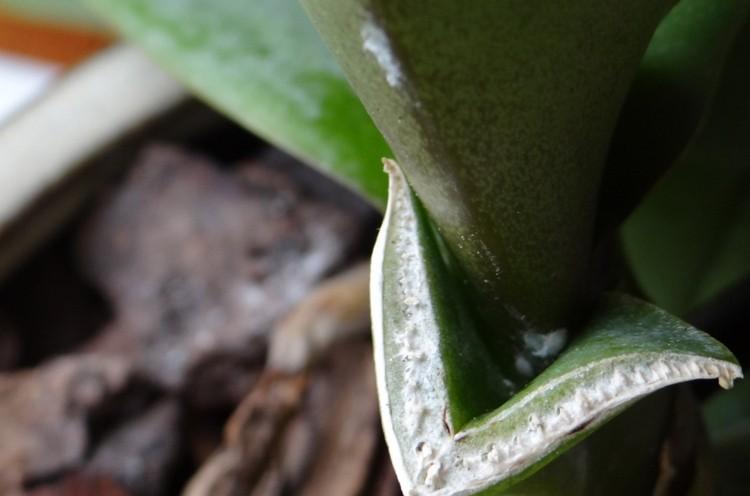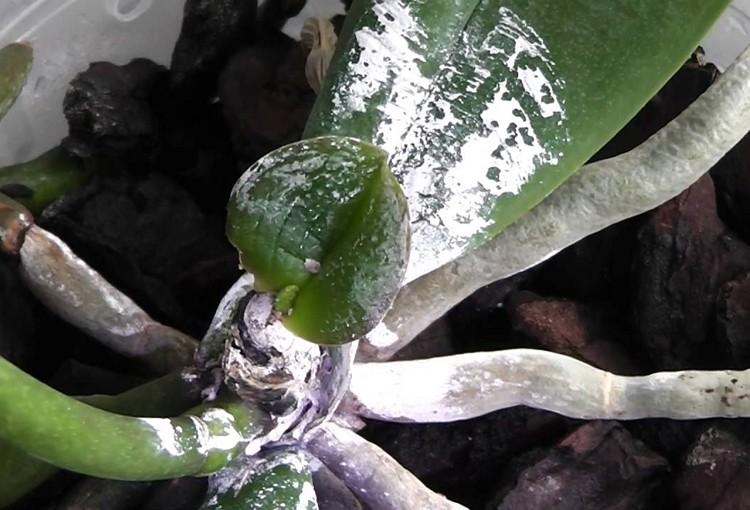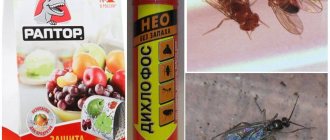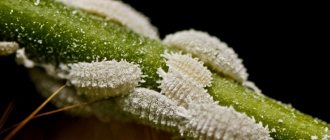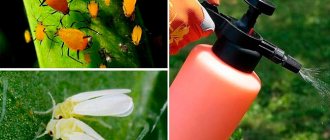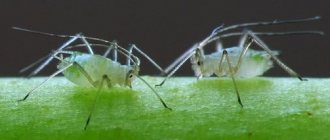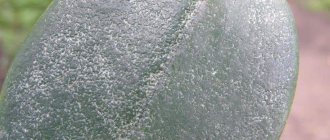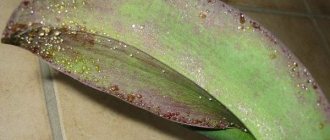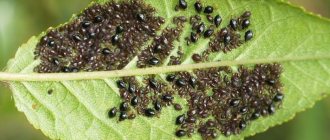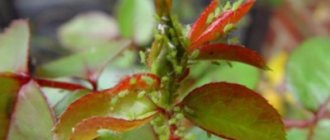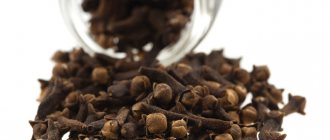The worm on orchids is a type of indoor flower disease caused by the appearance of parasites. It is easy to notice the appearance of pests by the condition of the leaves and roots of the plant. You can cure an orchid from mealy and root bugs at home using a chemical or folk remedy. In addition, there are a number of preventive measures that can help keep your indoor plants safe from future parasite attacks. For more information, read this article.
Symptoms of the disease
The fact that your orchid is affected by a mealybug is impossible to be mistaken, since no other parasite leaves behind a white mealy afterbirth. That is, if you are even a novice florist, then by the whitish bloom on the leaves or flowers, determine exactly who is guilty of the orchid disease.
There are other, less pronounced signs of damage. At the site of the puncture of the leaf shell or flower petal, chlorosis spots are formed, which darken over time. At the same time, the leaf or petal becomes lethargic. Over time, whole eaten holes can form in the outlets.
If you do not take measures in time, do not destroy the insect larvae, then soon sticky drops will begin to appear on the leaves and roots of the orchid. Next comes the deformation of the stems and leaves. That is, all the signs of plant weakening are evident. At this time, the orchid can be affected by fungal or viral diseases.
It is very difficult to confuse mealybug with anything. The appearance of white bloom on orchid leaves is one of the main symptoms of the appearance of this pest. Chlorous spots form in the places of the bites, sometimes they darken, the green plate becomes lethargic. Whole hollows can form in the outlet, eaten away by the parasite.
The appearance of sticky drops on the leaves and roots. Deformation of stems and leaves often appears, the flower looks underdeveloped and is often infected with concomitant diseases - of a bacterial, fungal and viral nature.
The reasons for the appearance of the pest
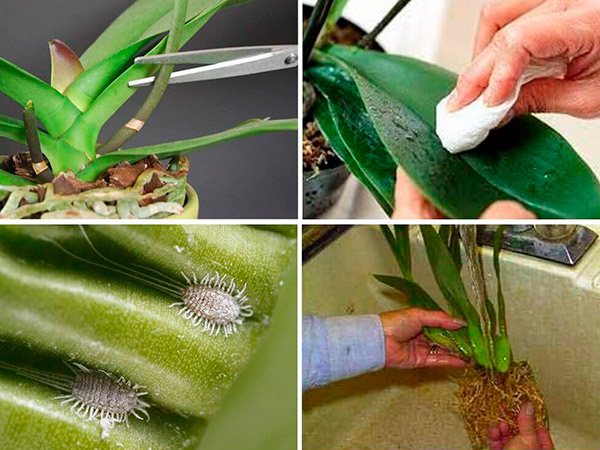
Outwardly, the pest is a tiny insect that is difficult to see without a magnifying glass; you need to carefully examine the plant. It predominantly lives on the lower surface of orchid leaves or flower petals, where it is much easier to access the plant sap. Not only does the pest suck out the juice, it also injects a disease-causing substance into the plants. This leads to the fact that the leaves become softer, it is easier for the parasite to pierce them.
The insect is very prolific. After mating, the female of this pest is capable of laying up to five clutches of eggs per season. Females secrete white threads, entangle themselves with this wax powder.
On orchids and other indoor flowers, two types of worm parasites are commonly found. These are the so-called citrus and bristly mealybugs. On home flowers, bristly grows more often. Despite its negligible size, the insect is able to quickly move from one plant to another.


If you find signs of this pest on one of your houseplants, take action immediately.Otherwise, very soon, all your flowers will be affected by this insect.
With careful care, mealybugs do not appear on orchids. On the other hand, the appearance of a pest is a signal that you are carelessly caring for a flower. At the same time, the appearance of the worm is not associated with any one violation of the rules for caring for orchids.
There are many reasons for the infection. It can appear from a violation of the required climate, improper watering, uncomfortable ambient air humidity for a flower, scarcity of soil, or, conversely, from its oversaturation with fertilizers.
How to rid an orchid of a mealybug
It's unpleasant, but a mealybug has started up on the orchid - unfortunately, many growers are faced with this. How to get rid of it? How to save a plant?
To do this, in general, is not difficult, but only if measures are taken in time. At the first detection of signs of the appearance of a parasite, all affected areas must be cleaned. This is done mechanically using warm water, a soft brush or cotton swab.
Take this simple job very carefully. Even a tiny whitish bloom should not remain on the flower. After that, the orchid needs to be treated with a special preparation (insecticide) or one of the homemade folk remedies.
Exotic orchids are no less susceptible to pest attacks than other indoor plants. Mealybugs are not the last among them. You will learn from this material about how to find and how to get rid of mealybugs on orchids, as well as what preventive works exist to prevent the disease.
Despite the name, mealybugs are not related to worms. It is an insect and belongs to the Hemiptera family. By way of life and some other characteristics, the scale insects resemble scale insects, although they belong to a different family.
Outwardly, adult female mealybugs are a rather large insect (on average about 5 mm long) with an oval flattened body of white or pinkish color. Above, the body is covered with a mealy wax coating. There are fringes around the circumference. Sucking mouth apparatus.


During the ovipositor, the female forms an egg sac around herself, resembling a cotton ball. Moving vagrant larvae emerge from the eggs. They actively migrate, they can even be carried by the wind.
Orchids are exotic plants that are very demanding on keeping conditions.
But in addition to the hassle of organizing the correct lighting, watering and feeding, flower growers have to fight diseases and pests that often affect this flower.
If a mealybug is wound up on an orchid, how to get rid of it? To save a houseplant, you will need to take a number of measures.
Mealybugs are small insects also called hairy lice. The species is related to the scale insect and false scale insect.
You can notice this parasite with the naked eye. It has a small, 3 to 6 mm in size, oval body of white or beige color, along which small bristles are located. The insect is very mobile and fertile, and, having hit one plant, it may well move to its "neighbors".
To date, more than 2000 varieties of mealybugs are known, most of which prefer to live in tropical climates. In the European territory, the following populations are considered the most common:
- Seaside scale insects. This parasite grows in size from 2 to 5 mm and has a light gray or pink body covered with wax. The insect's legs are well developed, which allows it to move quickly. Females of the seaside variety, unlike males, are unable to fly.
- Cactus bugs. These insects have an oval body over 3 mm in length, painted pink.Females of this species are viviparous, forming a felt bag.
- Bristly worms. Representatives of this species reach 5 mm in length, and they can be recognized by their orange or pink body color, covered with a bloom. Such parasites are viviparous and quite fertile, which allows the population to quickly spread throughout the plant.
- Grape bugs. These insects have a wide body with a length of 3 to 4 mm, which has a pink or green color. The bristles of the parasite are covered with a white coating, the tarsi are well developed, the last pair is the longest.
- Citrus bugs. This parasite reaches 3.5 mm in length, and the shade of its body, covered with a bloom, ranges from bright yellow to light brown. The insect has sticky bristles on its sides.
- Root worms. It is a small insect, the length of which ranges from 2 to 3.5 mm. The body of the parasite is elongated and can be whitish, yellowish or pink. Females lay oval-shaped white eggs, protected by cotton-like secretions.
The mealybug feeds on plant sap, which causes significant damage to them. The orchid affected by the pest has a painful appearance, intensively loses its leaves, and the buds crumble without blooming.
In addition, in the process of vital activity, the worms secrete a liquid that has a detrimental effect on the plant. In fact, it is a poison that slowly kills indoor flowers. In addition, "nectar" provokes the reproduction of pathogenic bacteria and fungi, and also attracts other parasitic insects.
If you do not remove the mealybug from an orchid or other plant, this will lead to depletion and rapid death of the culture. For this reason, measures should be taken immediately after the first signs of infection have been noticed.
We suggest that you familiarize yourself with Folk remedies for bedbugs in an apartment: how to get rid of bedbugs
Any type of indoor orchid can suffer from mealybug attacks. In addition, the parasite can grow on gerberas, fuchsias, hibiscus, amaryllis, oleanders and cacti. Often he chooses grapes, palm trees or citrus crops as a habitat.
Infected plants develop worse, shoot growth slows down. The main problem when treating indoor flowers is that worms often lay eggs in areas that are difficult to process.
Before proceeding with the question of how to get rid of the mealybug, you should find out for what reasons it appears. The provoking factors include:
- low air humidity;
- wrong temperature regime;
- incorrect watering and waterlogging of the soil;
- excess nitrogen in the soil as a result of fertilizer overdose;
- the presence of dead parts on the plant that were not removed in time.
How to understand that worms are parasitizing on an orchid? It is simply impossible to confuse them with any other pest, and the main sign of the presence of these insects is a whitish coating that resembles cotton balls.
The second symptom is a sticky discharge that forms on the leaves and stems of the crop, it is called honeydew or honeydew.
It is possible to save an orchid only if the necessary measures were taken immediately after the detection of alarming symptoms.
When the plant is slightly infested with mealybugs, the parasites can simply be collected and squashed. But what if the pest colony has grown? In this case, treatment with chemicals or formulations made from improvised means will help.
Chemical compositions are most effective in the fight against young insects. But since worms of different ages can parasitize on a houseplant, the culture will have to be processed several times, repeating these manipulations every 10-14 days.
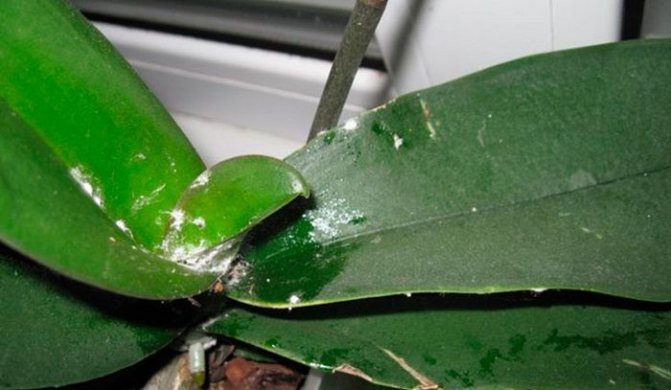

Among the variety of tools that can help in the fight against parasites, three main groups can be distinguished:
- Contact poisons that enter the insect's body through the skin. The most common drugs in this group are Spruzit aeschadlingsfrei.
- Intestinal toxins that enter the insect's body through the mouth. Such compositions as "Actor", "Actellik" and "Nurell-d" have proven themselves well.
- Systemic compounds that get into the sap of the plant and make it poisonous. The greatest efficiency can be achieved by using agents such as "Phosphamide" or "Rogor".
The components of the listed preparations are safe for the plant, but destructive for the parasite. Once in the body of an insect, substances cause its rapid death.
To cure an orchid and get rid of a mealybug, it is not necessary to purchase expensive drugs. You can treat the flower with a solution prepared yourself.
The most common treatments for parasite colonies are:
- Olive emulsion. For cooking, you need 200 ml of water and 50 g of olive oil. The components are mixed, after which the affected areas are treated with a piece of gauze or a cotton disc.
- Soap and alcohol. To prepare such a solution, you will need a liter of boiling water, 20 g of shavings from laundry soap and 50 ml of vodka. The ingredients are boiled for several minutes, allowed to cool, and then used for spraying twice a week.
- Garlic. To prepare the product, you will need 500 ml of boiling water and a few chopped garlic teeth. The solution is used to wipe the affected parts of the culture.
Any problem is easier to prevent than to get rid of. To protect orchids from mealybugs, you will need to follow a few rules:
- Keep a newly acquired "pet" separately from other plants for 10-14 days.
- Properly care for orchids, observing the watering and lighting regime.
- Regularly feed the flower to increase its immunity, since parasites most often affect weakened plants.
- Remove dead parts of the culture in a timely manner.
- Periodically arrange "shower" for orchids when the water is heated from 40 to 50 degrees.
By following these rules, there is a chance to minimize the risk of mealybug infestation of orchids.
The orchid fell in love with many flower growers due to its beauty and long flowering - with proper care, it can delight the eye with its flowers for more than six months. However, when growing this beautiful plant, you often have to deal with various pests and diseases that affect the flower.
Quite often, their leaves can be covered with a light, as if cottony, white bloom - a sign of the presence of a mealybug. The reasons for the appearance of the pest may be different, but the only correct solution would be the immediate destruction of individuals.
At the first signs of the emergence of a mealybug on orchids, it is worthwhile to arm yourself with means of combating it. However, before getting rid of individuals, you should find out what species they belong to. Today, 2 varieties are known that can infect an orchid:
- Citrus. These individuals have pronounced sexual dimorphism. Females are oval, yellowish, pinkish or dark brown in color, the body of which seems to be sprinkled with flour. On the sides of the pests, short bristly hairs are noticeable, and the size of individuals reaches 5 mm. Over the entire period of existence (about 3 months), the female lays up to 400 eggs. Males of this species are flying. An adult male lives only 2-4 days;
- Bristly. Females of this variety at home are reddish or orange in color, body 4-5 mm long and long hairs in the back of the body. The surface of the insects is also covered with a light coating. Males resemble a moth and a fly, have a grayish body color and transparent wings.
Precautions
Since Aktara belongs to the 3rd class of chemical hazard (moderately hazardous substances), when working with it, the following recommendations and safety requirements must be observed:
- do not use food containers for the preparation of working solutions;
- put on clothes made of dense fabrics and use personal protective equipment (gloves, glasses, respirator) in preparation for processing and directly during it;
- do not eat, drink or smoke while processing plants;
- when working with insecticide on the street, take into account the direction of the wind (do not spray the working solution against the wind);
- if a poisonous liquid gets into the eyes or on the skin, it must be washed off immediately with plenty of running water;
- in case of poisoning with an insecticide, you should immediately consult a doctor;
- it is prohibited to use Aktara for orchids and other plants if the drug has expired (it is 4 years from the date of manufacture).
What conditions are favorable for breeding
You can remove a harmful insect in two ways: mechanical and treatment with drugs (you can handle both purchased products and homemade products).
TIP: Not only the plant needs to be processed, but also the location of the flower pot.
This is a very tenacious insect, so often mechanical treatment alone may not be enough. Even if at least one larva remains, it will be able to degenerate a new generation of lice. Therefore, we recommend not to risk it and adopt one of the proposed means:
- Fitoverm (Kills both adults and larvae, causing them complete paralysis).
- "Bankol" (Comfortable for use due to the complete absence of odor, the effect is observed on the second or third day after application).
- "Aktara" (Quite a powerful tool that can destroy the pest in 4 hours. Experienced flower growers recommend adding the drug to irrigation water. Then the protective effect will last up to sixty days).
- "Mospilan" (A characteristic feature is the ability to destroy not only larvae, but even egg-laying).
Whatever one may say, but any chemistry is toxins, albeit sometimes weak ones. Therefore, you should only use the above products with gloves. After application, ventilate the room, wash hands and face thoroughly with soap under running water, rinse mouth with clean water, in case of contact with eyes, rinse immediately with running water.
To get the full effect, after treating the orchid with chemicals, put a plastic bag over the flower.
We suggest that you familiarize yourself with How to get rid of aphids on orchids at home
Folk ways
Among the folk remedies are the following:
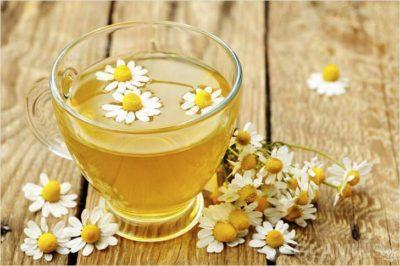

Chamomile decoction. To prepare it, take 200 grams of flowers and the green part of chamomile, fill it all with one liter of boiling water and put it in a dark place for half a day. After this time, strain the tincture and add another three liters of liquid.- Garlic tincture. Pour 5-6 cloves of garlic with boiling water and leave for about twelve hours. Strain, spray the orchid with the resulting mass.
- Onion broth. Boil the peeled onion for a few minutes, cool the water and then strain.
- Pepper tincture. Pour 50 grams of hot pepper with half a liter of boiling water (it is better to boil for five minutes), set aside and then strain.
Some experts advise treating orchid leaf plates with alcohol. But this must be done with special caution, since evaporating alcohol burns the leaves.
All preparations form an invisible film on the surface of the plant, which interferes with the process of photosynthesis. Therefore, wipe the flower after processing with a cotton swab dipped in clean water. Any treatment must be carried out at least twice with an interval of one week.
When fertilizing the soil in which your houseplants grow, be extremely careful. You should not use a large amount of fertilizing agent - this can create excellent conditions for the reproduction of pests. The mealybug settles on indoor plants, which are regularly fed with a large amount of fertilizers containing nitrogen. These are excellent conditions for a pest.
The ideal temperature for breeding is 24 ° -27 ° C. The mealybug lays many eggs and the larvae appear very quickly. Plants that are healthy are practically not threatened by pests. Like any living organism, house flowers produce special protective substances and can scare off the worm on their own, having excellent immunity.
Florist reviews
Maria, Chelyabinsk. Aktara was saved from the scabbard invasion. I tried to remove insects mechanically, covered the leaves of the cymbidium with soap, but they kept on and on. When I noticed that several flowerpots were affected, I used aktara. In literally two treatments, insects disappeared completely and did not appear again. Now I constantly keep Aktara next to the plants.
Ekaterina, Kazan. Best insecticide I've tried. Poisons everything that comes under the "hot hand". The granules dissolve well in cold water. Affordable price. She processed orchids - sprayed on all sides and soaked the pots in a basin. Moreover, the solution that remains can be used for other plants without fear of infection and epidemic.
Antonina, Nizhny Novgorod. Instant impact combined with the total destruction of all parasites. I think I literally heard the larvae and insects falling from the plants to the floor. I used it normally in the apartment, no consequences or allergies were observed. It is important to follow the instructions on the packaging and ventilate the area after processing. If it's really scary to get poisoned, then the plant can only be watered / soaked.
Chemicals
How to remove a mealybug from an orchid? The use of chemicals, i.e. spraying with an insecticide, is considered a last resort. This method is used by flower growers only when folk methods of struggle are no longer helping the orchid.
In flower shops, special contact insecticides are sold to combat parasitic insects. They are applied to the surface of infected orchid leaves and branches. Such drugs scare away or destroy parasites.
In addition, there are so-called systemic plant treatment chemicals. The principle of their effect on parasites is completely different. These substances are absorbed by the plant and infect insects when they suck the juice out of it. Simply put, the poison is spread through the sap of the plant.
Of course, these drugs have an undeniable advantage: they are not sprayed, but permeate the soil. As a rule, one watering is enough to completely destroy the mealybug. The disadvantage is that the drug negatively affects the plant itself - under its influence it also weakens, it must be fed abundantly, and it is better to completely replace the soil in the pot after the parasites disappear. The most affected parts of the plant are cut off.
Photo
Below you will see how the signs of the disease look in the photo.
Why an insect is dangerous
For nutrition, the pest uses the sap of the plant, thereby causing damage to it. But the most unpleasant thing is that in the process of vital activity, the worm secretes nectar, the special composition of which becomes the cause of the reproduction of molds and attracts other insects. Reproduction is very fast. If you do not take action, the plant may even die.
Among this type of pest, there are also females that do not need males for reproduction. Some subspecies are capable of producing offspring without laying eggs.Viviparous individuals reproduce larvae that are ready for independent life.
Advantages and disadvantages
Before using Aktara against pests that pose a danger to orchids, you should carefully study the positive and negative characteristics of the insecticide. They are as follows.
Advantages:
- high efficiency against a wide range of dangerous insects;
- minimal phytotoxicity;
- resistance of the active component of the drug to elevated air temperatures;
- providing a long-term protective effect;
- the ability to quickly penetrate into plant tissues;
- profitability and affordable price.
Folk ways of protection
How to cure phalaenopsis from diseases carried by mealybugs using folk methods? The indisputable advantage of folk remedies for insect control is that all of them, unlike insecticide solutions, are environmentally friendly, that is, the plant itself is not endangered. How to treat an orchid from a mealybug?
The whitish afterbirth is most easily removed with an alcohol tincture of calendula, which is sold in pharmacies. She rubbed the affected areas with a cotton swab. It is easy to save a plant at the initial stage of the disease.
All of the above problems will never affect you if you follow all the rules for caring for orchids. Diseases in an orchid often begin from the fact that a pest has started - a mealybug. Remember that mealybugs appear on weakened phalaenopsis, in which the leaf sheaths are loose. This parasite will not bite through the leaf of a healthy orchid.
Olga Danilina
Prevention methods
The most important method to prevent damage to any flower is to carefully examine it regularly and create comfortable conditions for its development.
Remember! The worm attacks weakened orchids that grow in inappropriate conditions.
Conditions for the development of a mealybug:
- too dry air in the room where the orchid grows;
- waterlogging of the substrate;
- an excess of nitrogen fertilizers in the soil;
- lack of lighting;
- low air temperature (below 15 degrees).
Important! Weakened orchids with reduced immunity are massively affected by the felt.
Therefore, the main measures for protecting plants from mealybugs are to increase immunity and create comfortable conditions for the flower. A particularly difficult period for orchids is autumn and winter with dry air in our apartments and short daylight hours.


What you need to do to reduce the risk of felting contamination:
- create an area of increased (at least 80%) humidity around the orchid. This can be achieved by spraying the plant and placing flat containers of water near the flower;
- wipe the orchid leaves daily with a damp cotton swab. Every month, you can add a few drops of Epin or HB-101 (per 1 liter of water) to the wiping solution, or dissolve a tablet of succinic acid;
- arrange a hot (above 35 degrees) hot shower for a flower weekly;
- water the orchid only if the substrate dries up;
- arrange additional lighting on the shortest winter days;
- perform all operations related to watering and sprinkling only in the first half of the day, so that the plant has time to dry out by night;
- do not use nitrogen-containing fertilizers in the autumn-winter period.


Where does the felt maker come from?
Mealybug does not come out of thin air. Therefore, the main method of prevention is to install a barrier to prevent it from entering your home. To do this, all flowers that have come back to your apartment must go through a monthly quarantine without fail.
During the entire quarantine period, it is necessary to inspect a new flower and the substrate in which it grows at least 2 times a week in order to timely identify possible infection.
When replacing the substrate, the new soil must be disinfected with a saturated solution of potassium permanganate, dried and only after that transplant the orchid.
Important! Watch out for insects, especially ants that suddenly appear on your windows - they can carry the eggs of the mealybug.
In summer, if the flower is on a balcony or by an open window, parasites can enter the orchid pot with a stream of air.
What is the danger of the parasite for plants?
IMPORTANT: As sucking insects, hairy lice feed on orchid sap. After this process, the plant loses the moisture it needs, nutrients, and the work of the conductive tissues is disrupted. All this leads to the fact that the orchid cannot carry out photosynthesis, which is the key to its life.
In addition to everything, the worms secrete saliva, which contains many toxic enzymes that adversely affect the culture. After all these "tricks" of lice, the orchid's protective barrier is significantly reduced, which leads to infection with other parasites.
Most often, a mealybug appears on an orchid, which today adorns the window sills of residential apartments and offices.
The pest also affects citrus fruits, cacti, philodendrons, amaryllis, gerberas, oleanders, fuchsias, palms, asparagus, anthurium, monstera, hibiscus and grapes.
If the plant is infected, then its leaves may turn yellow and fall off, and the shoots do not grow as fast as they should. If, in addition, a white bloom has appeared, then you can be sure: a mealybug has wound up on the plants.
How to fight
with an insect that infects citrus fruits, crawling under the bark or invading the tubers of bulbous plants? The problem of removing the parasite is largely complicated due to the fact that the pest lays eggs in places that are difficult to access for processing.
Protection of neighboring house plants and prevention
Neighboring plants can become infected. The larvae are capable of active movement. They can also fall on plants with a stream of wind. This applies to absolutely all indoor plants located both next to the affected orchid and within the room.
Therefore, the most important and first recommendation when finding a sick orchid is to isolate the flower in another room.
To prevent the active life of the worm on the orchid, you should adhere to elementary preventive measures, including:
- Regular close inspection of the plant surface, including the back of the leaves.
- Ensuring optimal conditions for keeping the orchid, observing the temperature regime of the room.
- Timely cleaning of the orchid from dry and affected areas of leaves, shoots, buds.
- Compliance with the irrigation schedule using the optimal amount of settled water.
- Intermittent use of a warm shower using a water temperature of about 35 ° C.
Also, each new plant in the house should be placed separately from other plants for several weeks, preventively treated with a broad-spectrum insecticide. If there are no signs of damage within three weeks, the plant can be placed next to the rest.
Signs of defeat
It is rather difficult to confuse this attack with any other pest. After all, the main external feature of the fact that the orchid is subject to the negative influence of hairy lice is a white fluffy bloom, very reminiscent of medical cotton wool. Another sign of damage can be called the presence of a shiny wax coating in the places where the sap of their plant is sucked out. The mealybug can infect any part of the orchid, from the shoot to the delicate flower.
Let's list the errors that lead to the appearance of hairy lice on an orchid:
- Improper watering. The flower grower either moistens the soil too much, or, conversely, overdries the soil too much, sometimes forgetting to water the flower or doing it deliberately.
- Everyone needs hygiene, but they did not respect it. You need to constantly wipe the leaf plates and bathe the orchid in the shower.If you forget about this, not only mealybugs can appear on the plant, but also many other harmful insects.
- Newcomers were not quarantined. As soon as you bring a new plant into the house, do not rush to put it with the rest. Quarantine for one to three weeks to identify existing parasites.
- Windows are not protected. There are cases when mealybugs were brought into the house by gusts of wind along with dust. Therefore, if you have vases with flowers on your windowsill, hang a small mosquito net on the window.
We suggest that you familiarize yourself with How to deal with the scale insect on orchids
The following symptoms indicate that a mealybug has appeared on orchids:
- the presence of flour plaque on leaf plates;
- the appearance on the leaves of honeydew - sticky secretions;
- the formation of light spots in the damaged areas of the leaf.
In an orchid infected with a worm, the leaves begin to turn yellow, wilt, and then the leaves fall off. The buds of flowering plants and already blossoming flowers are also affected. A large number of pests contribute to the deformation of young shoots.
Causes of flower damage at home
A mealy pest never appears on a plant for no apparent reason. The correct conditions for keeping orchids are not suitable for the life of the insect. However, some deviations from the rules lead to its appearance. The main reasons for which the worm appears on an orchid are:
- Incorrectly selected fertilizer - an unbalanced ratio of minerals, nutrients lead to poor plant development, root rot and moisture stagnation.
- Lack of lighting - if the orchid is not properly positioned relative to the sun, photosynthesis is disrupted and moisture accumulates, which also leads to root rot.
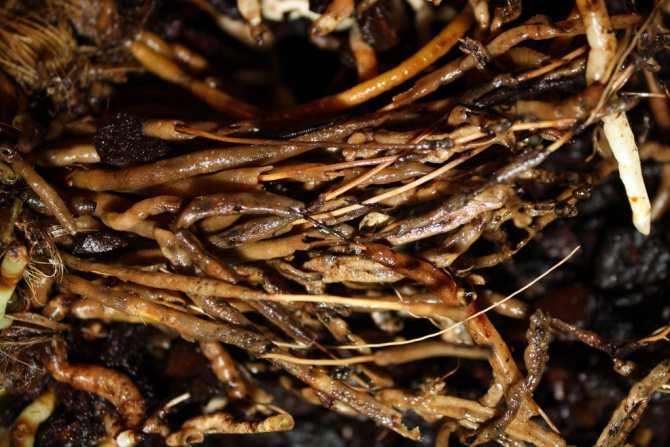

Root rot
- Failure to comply with the temperature regime - the rate of absorption of nutrients is disrupted, the plant's immunity is weakened. The optimum temperature is between 23-25 degrees.
- Poor quality soil - the root system suffers, proper aeration does not occur, the drainage structure is disturbed.
- Excessive watering of the orchid and the use of poor-quality water - the high humidity of the substrate leads to rotting of the plant, and the use of hard and cold water creates optimal conditions for the insect to inhabit.
How to fight
On the Internet, you can find recommendations for treating orchids with oil-based products or pure oils. But experienced flower growers say that this is detrimental to the flower. The oil clogs the airways of the plant, and it gradually weakens. Also, removing the oil is not easy.
There are three classic methods of complete extermination of pests: mechanical measures, chemical treatments and traditional methods. All of them can help you in different ways, but if you apply them in combination, the result will definitely not be long in coming.
Mechanical methods are measures that are completely tailored to your physical fitness. Usually this is a hand-made collection of pests, setting traps and other manual work. In the case of the mealybug, only manual removal of the beetles from the stems and leaves of plants will make sense. However, you can do this only when the beetles gain enough weight and size, that is, they already have time to harm the plant. Accordingly, the mechanical method will be effective only in advanced stages and only in combination with, for example, folk methods.
Another method that can be attributed to mechanically is the washing of the flower roots. The bottom line is that you simply dig up the orchid, rinse the roots, leaves, stems and plant back.
Chemicals
- Disinone. A very effective drug that kills most of the insect population from the first use. There is a drawback: it has a sufficient level of toxicity to cause harm to humans. Cost: 800 rubles. Karbofos.A classic remedy in the fight against a huge number of pests. Including those with mealybugs. Available in various forms. A liquid weighing 50 milliliters costs about 200 rubles.
- Metaphos. It costs about 20 rubles. Available in small capsules. Applied to various types of planting is also a huge plus, because some insecticides are not suitable for use on flowers. In addition, this drug does not have a toxic level, does not pose a danger to soil microflora, humans or beneficial animals.
- Dimeotat. This insecticide comes in large 5 liter containers. Accordingly, its cost is not budgetary: about 4 thousand rubles. The protective effect of the drug for about 3 weeks is a fairly high indicator. It can be used in a duet with other drugs (except those that have an alkaline medium).
This is not so difficult to do. The main thing is to isolate the orchid from other, non-infested flowers. It is necessary to dilute the drug with water strictly in the proportions indicated in the instructions (it is possible that it is not necessary to dilute in water at all). After preparing the desired solution, start spraying / watering the affected flowers with it.
Reprocessing can also be carried out only strictly at the interval that is written in the instructions. It is best to repeat the treatment with another means, since there is a likelihood of addiction and the development of immunity in pests. You can also alternate insecticides that are in contact with intestinal or systemic. However, some can cause the disappearance of useful animals and insects in the garden, this can also become a kind of problem.
Spraying with chemicals is necessary in chemical protection or closed clothing. It is necessary to avoid getting the product on open skin, mucous membranes. Severe cases of poisoning are possible, in some cases, death. At the slightest sign of poisoning, you must immediately consult a doctor.
- Soap solution. The classic way to poison any pests is to “bathe” the plant in a soapy solution. To prepare it, you need to dissolve a bar of laundry soap in a bucket of water. You can simply wipe the stems, leaves and pour on the soil around, or you can lower the roots into a container prepared in advance and then plant it again.
- Oils are the enemy of the worm. Stir 3 tablespoons of olive oil in a liter of water, spray with orchids.
- If you have a tincture of calendula, it can also help kill the worm. To do this, wet a cotton pad in the tincture and wipe the lesions (important: during this method, you must avoid sunlight, so carry out the procedure in the evening).
- Garlic tincture is also an option. Stir chopped garlic in a liter of water (one head is enough). The solution must be insisted a little, and then mix again and water the affected flowers with it.
Since folk methods do not imply any harm to plants and humans, they can be applied in a free interval.
Description of the drug, characteristics, composition
Aktara (d.v .: thiamethoxam, 250 g / kg (g / l)) - it is an insecticide from the group of neonicotinoids, with a broad spectrum of action. Externally, it is a water-dispersed brown granules or a transparent, yellowish solution in ampoules.
Has no sharply perceptible smell. Effectively suppresses scale insects, false scales, mealybugs, whiteflies and other insects both when applied to the soil and when spraying on the leaf.
Produced by the Swiss firm Syngenta.
Issued by:
- In sachets 1.0, 1.4 g or 4 g each,
- In ampoules of 1.3 ml for use in the country or at room conditions,
- IN bottles 250 g each or vials 9 and 10 ml each for household plots focused on the sale of goods,
- And also in cans of 1 l for large farms, farms, etc.
Attention! Beware of counterfeits, try to find an original drug that will fully meet the declared characteristics.


How to cure: step-by-step instructions for getting rid of the pest
Do not expect that the fight against such an adapted insect will end quickly. Be patient and don't give up halfway through. As soon as you notice a pest on a plant, you should:
- remove all visible parasites;
- wash off the remnants in the shower;
- treat with an insecticide or homemade drug;
- if necessary, update the soil in the flowerpot;
- disinfect the surfaces on which the flower pot was located;
- remove the orchid in a separate place, protecting other plants from infection.
On the second day, you need:
- re-examine the plant;
- remove the remnants of the mealybug;
- fertilize the soil.
On the fifth day, repeat the treatment with insecticidal agents or folk remedies. Be sure to take a full look at the orchid. On the tenth day, you can again treat with chemicals. You will need to feed the weakened plant again.
ATTENTION: The quarantine lasts longer at least thirty days. That being said, do not forget about constant flower hygiene and a weekly shower for any orchids. Remember, only comprehensive and systematic treatment measures will help you defeat a harmful insect.
What is it and what does it look like?
ATTENTION: Popularly called hairy lice. They are sucking insects. Despite their miniature size (from three to six millimeters), they are very easily seen on plants due to their waxy secretions. A characteristic feature is their shaggy surface in a light shade.
Females lay eggs up to four times a year, which is considered an indicator of high fertility in the insect world. They can form numerous colonies that are capable of completely destroying the infected plant. In the adult stage, mealyworms stop feeding..
At the moment, there are more than one and a half thousand varieties of hairy lice that have adapted to living in all corners of the Earth. These individuals have only one pair of limbs, the rest are either reduced or completely absent, depending on the species.
Watch a video about mealy, what a mealybug is:
Physical methods and folk methods of dealing with mealybug
At home, the removal of parasites in the early stages of invasion is destroyed using the following technique. The leaves of the plant are cleared of parasites, all secretions are washed off. Parts of the flower that have suffered severe damage are cut out. The scales located on the pseudobulb are also removed, and the airy tubers are wiped with a damp cotton pad. The foliage, located near the surface organ, is pushed back, after which the larvae are removed with cotton wool.
You can fight pests using folk remedies:
- 4-5 garlic cloves are infused in 0.5 liters of boiling water. The resulting infusion is sprayed over the entire flower or used to wash the foliage on both sides.
- 1 tbsp. l. young shoots of ivy are poured with a glass of boiling water. The plant is treated with chilled infusion.
- The pot is filled with water and potato skins. The contents of the vessel are brought to a boil and heating is continued for another 10 minutes. The plant is treated with a solution cooled to 40 ° C.
Heating helps fight harmful organisms just as effectively. Care should be taken when using this method: sunbathing will burn the foliage of the flower. The mealybug on orchids is ruined by temperatures above 35 ° C. An effective measure is a shower for the plant, for which water is used at a temperature of 45-50 ° C.
We suggest that you familiarize yourself with: Fitoverm how to process indoor plants
An orchid is easier to clear of parasites at the beginning of infestation. Inspect the habitats of pests: young shoots, leaves, peduncles.Egg sacs with females are collected with a gauze swab. A cotton pad is moistened with calendula tincture in 70 ° alcohol and the plant is wiped.
Thoroughly peel off insects and threads from leaves, wash off sugary secretions. Severely affected parts of the plant are cut and destroyed. The scales on the pseudobulb are removed, and the air tuber itself is wiped with a damp cotton disc. The leaves covering the surface organ are pushed back, then the larvae are removed with a cotton swab.
To save an orchid from a mealybug, use one of the following methods:
- Insist 4-5 cloves of garlic in ½ liter of boiling water. The orchid is sprayed with a solution or only the leaves are wiped on both sides.
- Horsetail shoots are poured with boiling water (1 tbsp. L. Per glass). The plant is treated with chilled infusion.
- Fill the pot with raw potato skins and water, bring to a boil, and heat for another 10 minutes. The solution is cooled to 40 ° C and indoor flowers are sprayed.
A soap-alcohol solution is used against larvae and adult insects on orchids. The tool is prepared from 1 liter of soft water, 1 s. l. liquid soap and 2 tbsp. l. alcohol, strength 70 °. The roots and flowers are pre-covered so that the solution does not get into. The product is applied with a soft brush directly to the colonies of the worm.
Experienced growers know how to control pests with heat. The method is applied with care so that the sun bath or hot water does not burn the leaves. A temperature of 35 ° C and above has a detrimental effect on adults and larvae. A good result is obtained with a hot orchid shower (45–50 ° C).
Where dwells
Flower buds are considered a favorite habitat for insects. They often appear in the axils of the leaves and on their back, on young shoots. Individuals often settle directly on the windowsill, in flower pots, and even in the soil. A plant that is planted in open ground for the summer can be dangerous. If a mealybug appears, treatment and prevention may be needed for all home flowers. In any case, wet processing with a mild soapy solution and careful inspection will definitely not hurt.
Insecticidal preparations
To combat the larvae of the pest, chemical preparations of intestinal and contact action are used. Young animals that hatch from eggs or emerge from the womb are not covered with wax powder and threads. A contact insecticide enters the shell of the larva and causes death. The control of harmful insects has become more effective thanks to enteric pesticides. After processing, all parasites that feed on the plant die.
Spraying chemicals:
- "Fitoverm", "Vertimek" - intestinal-contact insecticides of natural origin, less toxic.
- "Aktara" is a drug poisonous for a large group of plant pests. The working fluid is prepared from 2 g of powder and 2.5 l of water.
- "Calypso" is an insecticide causing rapid death of insects when using a solution of 0.5 ml in 1 liter of water.
- "Actellik" - a remedy used on indoor plants in exceptional cases, with massive pest infestation.
An insecticide that does not control parasites is canceled. Choose another drug and spray it after 7-10 days. "Actellik" is considered to be a strong remedy. One ampoule of the agent is dissolved in 2 liters of water. The working liquid is sprayed on the stems, leaves on both sides, the solution is poured under the root. It will take 3-4 treatments with a break of 7 days.
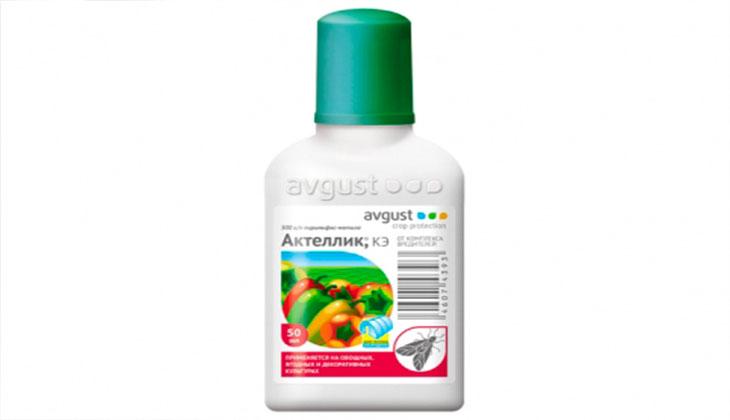

Tips for working with drugs:
- Insecticides are toxic substances. Before fighting the mealybug using chemicals, the orchid is taken out to the balcony.
- Prepare and apply the solution in rubber gloves, a respirator, protective clothing and goggles.
- After processing, the orchid is covered with a pre-prepared cap made of colorless polyethylene film. Peel off the coating after 24–48 hours.
- Do not eat food while working with pesticide solutions.
- The presence of children in the room where spraying is carried out is unacceptable.
- After the procedure, they remove the protective equipment, take a shower and rinse the mouth.
If soil pests are found, the orchid is transplanted. The roots can be treated with an insecticide after clearing the soil. The flower pot is washed with water, rinsed with a weak pesticide solution. Sticky tapes are hung against the winged males near the light sources.
Why do drops appear on the orchid
If sticky droplets appear on the orchid, this is not necessarily a sign of parasite infestation. But the florist needs to urgently analyze the care of the green treasure. There can be many reasons:
- Transpiration. This is a natural process for the formation of flower nectar. Through transpiration, man's green friends attract insects for pollination.
- Very dry air. In this case, room joy must be periodically moistened by spraying. Overdrying is typical for hot summers, but this phenomenon can also manifest itself during the heating season.
- Direct sunlight. Beauties, although from the south, do not like them. If there is a window sill on the shady side, you should rearrange the orchid to another place. You can artificially arrange a shadow for the green friend - curtain the window with a thick curtain or fence off the sun's rays with white paper.
- Excess moisture in the substrate or sump. Reduce watering.
- Bust with top dressing. Exotic beauties are capricious - they do not like anything superfluous. Some growers believe that feeding by the Yartyshnikovs is not needed at all, a good enough soil is enough. Overdoing it with fertilizer can stimulate sticky plaque.
If sticky formations appear on orchids, then the first step is to carefully examine the green guest. You should look into hard-to-reach places: buds, leaf axils, young shoots. All incomprehensible manifestations are best viewed with a magnifying glass. This will help you better see possible saboteurs.
How to protect your pets from unwanted attacks?
First, to provide growing conditions that exclude the optimal habitat of the pest, namely, the necessary air humidity, the required lighting, an optimally adjusted irrigation and feeding regime.
Secondly, regularly inspect orchids in your collection and timely remove naturally dried leaf plates, they often become an object of shelter for worms. Orchids should be bathed regularly under a warm shower.
Finally, the purchased new plants need to be quarantined in isolation from the rest of the orchid collection, and the soil mixture or substrate for epiphytes brought from the store must be disinfected by calcining in the oven or spilling boiling water.
Analogs


The drug can be used for prevention
According to the manufacturer's declared characteristics, this drug has no analogues that could replace it in terms of quality and effectiveness.
Nevertheless, there are several such drugs, the active ingredients of which destroy orchid pests.
Tiara
The composition includes an active substance - thiamethoxam, but the effect of this agent is not similar to the healing property of Aktara.
Price - 3200 rubles. for 1 liter.
Cruiser
It has a long-lasting protective property, more suitable for the treatment of seeds and soil plants. When irrigating orchids, it instantly penetrates the cells of all organs. It affects the nervous system of parasites that like to feast on the juice of flowers.
The cost for one bottle of 5 liters is 2500 rubles.
Doctor 8 arrows
A drug of domestic production, which has a good and fast action. It comes in the form of arrows. They are carefully inserted into the substrate. After that, irrigation of the aboveground part with a solution of laundry soap is required, since the active substance begins to act on the 8th day of application.
Price - 35 rubles.
Preventive measures
Any disease is always easier to prevent than to cure, therefore there are a number of measures to prevent the appearance of a mealybug:
- Purchased orchids must be quarantined for 14 days to ensure that the plants are healthy.
- Periodic inspections of flowers for the appearance of pests. Small colonies of worms are much easier to destroy.
- Control over the correct conditions of detention. Healthy plants are rarely attacked by parasites.
The appearance of diseases and pests on orchids is not a reason for panic. First of all, problematic specimens are isolated, and treatment begins. In the larval stage, worms even survive chemical treatment; it is necessary to return the plants to their permanent residence only after their complete recovery.
Description of the insect and harm caused
Mealybug is an insect with an oval, waxy bloom up to 6 mm long, usually painted white, light beige or pinkish. The people call these insects "hairy lice" or "felt lice". On the back of the worm there are transverse grooves, and small bristles are located along the perimeter of the body. These insects, which are relatives of the scale insects, inhabit not only plants, but also the substrate in pots.
Males are equipped with wings, but they have no mouthparts: adults do not need food, since they die after mating. Females have no wings, but they have a long proboscis with which they pierce the ground organs of the plant to suck out the sap. Before laying eggs, the female produces a cotton-like substance that covers the leaves of the plants with a white coating. It is from this raid that the presence of worms is guessed.
In one season, the insects give 3-4 generations, and the light gray fluffy larvae also begin to suck the juice from the orchid.
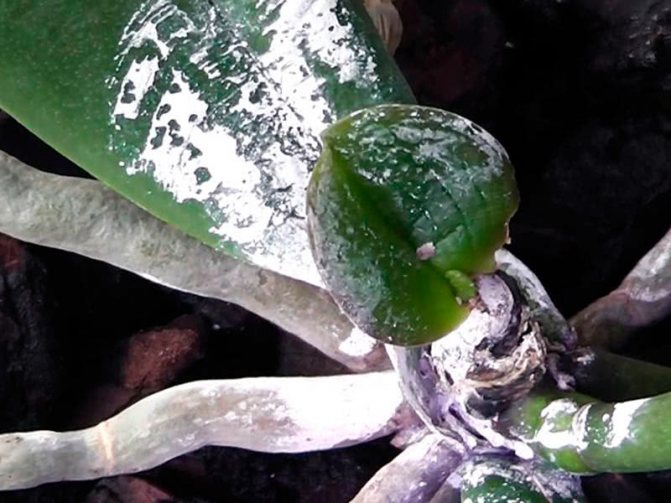

Most often, the worms hide in the depths of the leaf sinuses, crawling into the buds and flowers. As a result of their vital activity, the leaves are covered with a white marble pattern, orchid flowers are deformed, the plant weakens and becomes easy prey for various infections, and the digestive enzymes of pests slow down metabolic processes in the plant. The sweetish secret of the worms, which is more often called padya, is a favorable environment for the sooty fungus, which covers the terrestrial organs of the orchid with a black bloom.
Expert Advice on Treating Orchids with Chemical Insecticides
Despite the low phytotoxicity of Aktara, experts warn about the need to take precautions when working with this drug:
“The dosages are written in the instructions for a reason. Chemicals can be conditionally not phytotoxic, but if the recommended dosages are grossly exceeded, they begin to inhibit the plants. The concept of "lack of resistance" is also very conditional. Insects in the long term get used to any chemical influences. Therefore, even such drugs, to which no cases of addiction in pests have yet been identified, should alternate with chemicals from other classes or with biological insecticides. "
S. Ryzhkova, florist with 15 years of experience
Practice shows that Aktar can be alternated with drugs from the following classes:
- pyrethroids ("Alatar", "Inta-Vir");
- avermectins (Fitoverm, BioKill);
- bacterial insecticides ("Lepidocid", "Bitoxibacillin").
Rotation of "Aktara" with bacterial insecticides and avermectins gives the best result. It must be performed according to a certain scheme. In case of severe damage to orchids by pests, "Aktara" is used. After 2-3 weeks, the plant is treated, for example, with "Fitoverm". After another 2 weeks, control treatment with Fitoverm is performed.
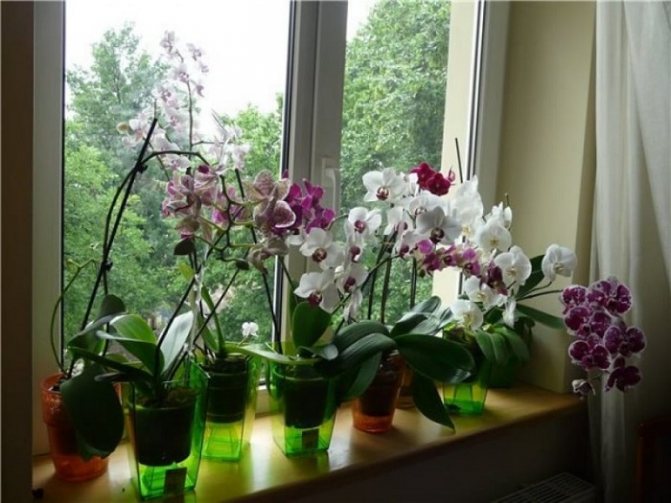

The use of competent rotation schemes for chemical and biological insecticides is guaranteed to protect orchids from pests, reduce the risk of developing resistance and pesticide load on plants.
Control measures
Getting rid of mealybugs on an orchid is very difficult. However, many growers know how to protect plants. There are many ways. You can use folk methods or carry out processing with chemicals. If insects were found on the plants, the flowers must be isolated urgently.
Folk ways to fight insects are very popular. First of all, they are affordable and economical.
The most popular are the following methods:
- Mechanical cleaning of plants
The affected buds must be removed. If insects have damaged the leaf plates, you need to wipe the leaves with a cotton pad. If pests were found at the root, the orchid needs to be planted in a different soil.
It is important that the largest accumulation of scale insects is observed on new processes. This area should be given special attention.
After the procedure, it is necessary to carry out the treatment with a soap composition. To prepare it, you need to take laundry soap, grind it, fill it with water. Rub the leaves and stems with the resulting foam. Finally, a fungicide treatment is required. In this matter, copper sulfate has proven itself well.
How to get rid of mealybugs on orchids in this way is of interest to many gardeners. It is enough to prepare a solution and water the plants with it. Orchids can be sprayed daily.
You can buy the tincture at a pharmacy. Before use, it must be diluted with water, in a 1: 1 ratio.
To prepare the composition, you need to combine a liter of boiled water, 15 ml of alcohol, 20 grams of liquid soap. With this solution, flowers are processed.
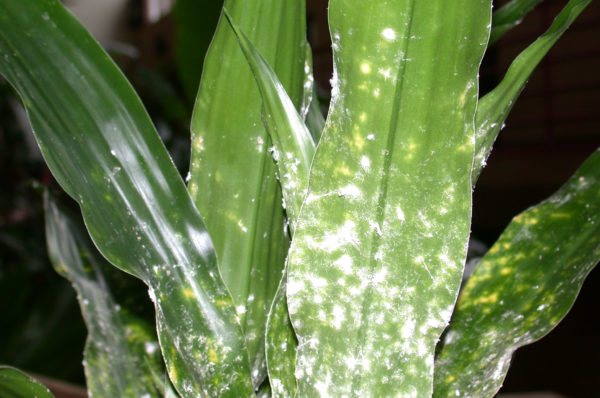

To prepare the mixture, you need to combine a liter of water and 60 grams of oil. Plants are sprayed with this mixture.
First you need to boil the water. Then add a head of minced garlic to it. Cook the composition for 1 minute. Then leave the liquid for 5 hours to infuse.
As soon as the composition has cooled, it must be filtered and the leaves and stems can be processed.
An affordable remedy to help get rid of the worm. A cotton pad must be moistened with tincture, and the affected areas can be treated.
Please note that the procedure is best done in the evening.
In addition to folk methods, chemical preparations help in the fight against insects. They allow you to completely get rid of pests and protect plants.
The most effective remedies are as follows:
- Actellik - used for massive damage to plants.
- Fitoverm - used to get rid of mealybugs on orchids, has an efficiency of up to 98%.
- Vertimek is an effective remedy, it is less poisonous than other drugs.
Instructions
First, you need to prepare a solution, observing the dosage:
- The granulated product must be diluted. Usually, flower growers take a 1.4 g sachet. A mother liquor is prepared - part of the granules is dissolved in a small amount of water. Then it is brought to the required volume with the addition of the remaining dry matter and water according to the instructions. Shake well before use.
- The liquid product should be diluted in the same proportions and dosage as the granular product.
- For spraying, the optimal dose is 1 g per 10 liters of water. This amount is enough to process about 120 plants. If you need to water at the root, spend 4 g per bucket of water.
What to do for prevention?
An orchid can be considered completely healthy only if not a single white mealybug cocoon has appeared on the plant for 1 month.
To prevent this indoor plant from knowing such a problem, it is necessary to organize a warm shower once a month.


To do this, the orhudey needs to be removed from the pot and, under a moderate stream of shower with warm water, wash the roots, the center of growth, leaves, peduncles and flowers.
When the water drains well, the center of orchid growth should be wiped dry with a dry paper towel. Moisture should not remain in this area, as this can lead to rotting of the plant.
Experienced growers recommend organizing a quarantine month for each new orchid. Of course, you want to immediately put the new plant to the rest, but you don't need to do this right away. A new flower from the store may be infested. The purchased orchid should be placed in a separate bright place for 1-1.5 months. During this time, the owner must make sure in what condition his new orchid is. If the plant does not weaken, continues to grow and bloom, then it can be safely rearranged to the rest of the indoor plants.
You also need to be careful about mineral fertilizers. You need to feed the orchid exclusively during the period of growth and flowering. Do not overdo it with the amount and concentration of fertilizer. The feeding process should be carried out no more than once every 2 weeks.


It should be remembered that there are special fertilizers for orchids. So that the plant does not hurt and actively form buds in winter, it is necessary to pay attention to the temperature of the air and water for irrigation. The water temperature should not be lower than + 35 + 36 ° С, while the air temperature in the room should not fall below + 20 ... + 22 ° С.
Release form
The manufacturer made sure that each grower finds a preparation suitable for the form of release. Some opt for a liquid in the form of a suspension concentrate, while others opt for granules that dissolve in water. When buying a product in solid form, you get a package with a weight of 4 grams. This dosage is enough to spray the orchid and rid it of the pest. Large farmers and owners of agricultural enterprises buy the drug, packaged in large packages of 250 grams. The suspension is commercially available in a vial or ampoule.

